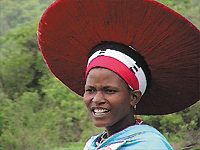|
From Mexican maquiladoras to South African wildlife preserves, Club's new international program extends helping hand
By Sarah Wootton
 What do a Namibian cheetah and a Mexican pollution-belching factory have in common? They're part of the Club's new Beyond the Borders program, an addition to the Sierra Club's existing international program. Working with community groups and non-profits, the Club will provide grants, workshops and resources for environmental advocates working primarily in Mexico and southern Africa to make their villages, towns and regions healthier and their lifestyles more sustainable. What do a Namibian cheetah and a Mexican pollution-belching factory have in common? They're part of the Club's new Beyond the Borders program, an addition to the Sierra Club's existing international program. Working with community groups and non-profits, the Club will provide grants, workshops and resources for environmental advocates working primarily in Mexico and southern Africa to make their villages, towns and regions healthier and their lifestyles more sustainable.
"In South Africa, one of the program's sites, there are incredible extremes," says Stephen Mills, director of the Club's International Programs on Population, Trade and Human Rights and the Environment. "One minute you'd swear you were in California and then you see the most excruciating poverty."
 In South Africa, Namibia and Angola, Beyond the Borders' African Wildlife Protection Grants Program will help communities protect wildlife. Healthy wildlife populations can mean more tourism in the area, which creates secure jobs for local workers. A more sustainable workforce, program organizers expect, will improve working conditions and help ease poverty in the region. In South Africa, Namibia and Angola, Beyond the Borders' African Wildlife Protection Grants Program will help communities protect wildlife. Healthy wildlife populations can mean more tourism in the area, which creates secure jobs for local workers. A more sustainable workforce, program organizers expect, will improve working conditions and help ease poverty in the region.
Southern Africans are very interested in protecting local wildlife, says Mills, because they recognize that it would help the entire community. Part of the Club's work will fund the recovery efforts for elephants and cheetahs through WILD (International Wilderness Leadership), which has spearheaded efforts to protect wildlife and habitat for 27 years.
Closer to home, the Club is embarking on a program to address the horrible conditions along the U.S. Mexico border from the U.S.-owned assembly plants, known as maquiladoras. When the Club Board of Directors met in Brownsville, Texas, last February, local volunteers and staff led them in an eye-opening tour of Matamoros, the squalid industrial city across the border from Brownsville. Club President Jennifer Ferenstein was shocked by what she saw.
"In Brownsville there are good roads, nice buildings -- affluence, basically," says Ferenstein. "And in Mexico, there are no sidewalks, just open sewers and garbage everywhere -- abject poverty."
More than 30 years ago, maquiladoras started cropping up on the Mexico -U.S. border. In 1970, 160 plants employed 20,300 laborers. In 1995, 2,136 plants employed 497,000 laborers.
"Illegal dumping of hazardous wastes, increased use of industrial solvents and an infrastructure overstressed for decades have made the area a hotbed of air and water pollution and toxins exposure," says Alejandro Queral, the Club's new border representative, who will provide training to groups on both sides of the border.
Beyond the Borders' Mexico Grant Project will help Mexican and U.S. community groups raise funds to put on events such as "reality tours" to raise awareness of the conditions created by maquiladoras and to provide training and other resources for employees and volunteers.
The San Diego Chapter is planning a grant-writing workshop for Mexican non-profits along the border. Liz Giffen, co-Chair of the San Diego Chapter's Border Committee, says the chapter plans to organize future Border Reality Tours, which take participants to visit the assembly plants and communities that are suffering most.
"Tour participants see firsthand what life is like for the people who work in the maquiladoras and live in shantytowns without public services such as potable water and sewage treatment," says Giffen. "A lot of people in San Diego live in a bubble and never venture over to the other side of the border."
"NAFTA promised it would bring jobs, a clean environment and better lives and instead it delivered an overflowing refuse pile," says Ferenstein.
In addition to funding community groups in Mexico and Africa, Beyond the Borders will contribute to fellowships through Ashoka: Innovators for the Public, which supports social entrepreneurs who work to help communities become more sustainable.
The fellowships provide three-year stipends for Ashoka Fellows like Allan Schwarz, an architect in Mozambique, and Heladio Reyes, an agricultural specialist in Mexico. In Mozambique, communities have clearcut their forests for money, leaving them with near-barren forests, a declining wildlife population and a lack of sustainable work. Schwarz has worked with communities to arrest the deforestation and has trained local craftspeople to create "heirloom quality" woodwork that they can sell.
In Mexico, Reyes is helping rural communities learn how to make their traditional style of agriculture and hunting more sustainable by introducing crop management, wildlife preservation and biological pest control.
The Beyond the Borders program will also help the efforts of the Human Rights and Environment Campaign and the Sierra Student Coalition to build grassroots support for threatened environmental defenders as well as for an "international right to know" program that would establish disclosure standards for U.S. companies operating abroad.
Photo of Zulu woman courtesy Steve Mills: Dressed to Impress: On a 'Beyond the Borders' visit to South Africa to attend the Seventh World Wilderness Conference, Michele Perrault, the Club's International vice president and Stephen Mills, director of the International Program, met the Zulu woman at left on her way to a wedding.
Photo of giraffe courtesy Michele Perrault: The Club new program in Africa aims to help local groups protect wildlife and habitat.
Up to Top
|